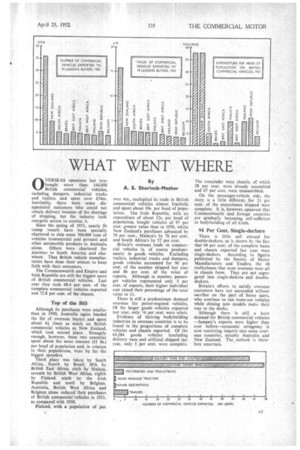WHAT WENT WHERE
Page 85

If you've noticed an error in this article please click here to report it so we can fix it.
By A. E. Sherlock-Mesher OVERSEAS operators last year bought more than 144,000 British commercial vehicles, including dumpers, industrial trucks and trailers, and spent over £74m. Inevitably, there were some disappointed customers who could not obtain delivery because of the shortage of shipping, but the industry took energetic action to combat it.
Since the spring of 1951, nearly 50 tramp vessels have been specially chartered to ship some 500,000 tons of vehicles (commercial and private) and other automobile products to Australia alone. Others were chartered for journeys to South America and elsewhere. Thus British vehicle manufacturers have done their utmost to keep faith with their customers.
The Commonwealth and Empire and Irish Republic are still the biggest users of British commercial vehicles. Last year they took 68.4 per cent, of the complete commercial vehicles exported and 72.8 per cent, of the chassis.
Although its purchases were smaller than in 1950, Australia again headed the list of overseas buyers and spent about 41 times as 'much on British commercial vehicles as New Zealand, which took second place. Strangely enough, however, these two countries spent about the same amount (11 8s.) per head of population and, in relation to their populations, were by far the biggest spenders.
Third place was taken by South Africa, fourth by Brazil, fifth by British East Africa, sixth by Malaya, seventh by British West Africa, eighth by Finland, ninth by the Irish Republic and tenth by Belgium. Australia, British West Africa and Belgium alone reduced their purchases of British commercial vehicles in 1951, as compared with 1950.
Finland, with a population of just over 4m., multiplied its trade in British commercial vehicles almost fourfold, and spent about 10s. per head of population. The Irish Republic, with an expenditure of about 12s. per head of population, bought vehicles of 97 per cent, greater value than in 1950, whilst New Zealand's purchases advanced by 79 per cent., Malaya's by 76 per cent. and South Africa's by 52 per cent.
Britain's overseas trade in commercial vehicles is, of course predominantly in goods vehicles. Excluding trailers, industrial trucks and dumpers, goods vehicles accounted for 96 per cent. of the number shipped last year and 86 per cent, of the value of exports. Although in number, passenger vehicles represented only 3 per cent. of exports, their higher individual cost raised their percentage of the total value to 11.
There is still a predominant demand overseas for petrol-engined vehicles. Of the larger goods vehicles exported last year, only 16 per cent. were oilers.
Evidence of thriving bodybuilding industries in overseas countries is to be found in the proportions of complete vehicles and chassis exported. Of the 69,284 goods vehicles (excluding delivery vans and utilities) shipped last year, only 5 per cent. were complete. The remainder were chassis, of which 28 per cent. were already assembled and 67 per cent, were unassembled.
On the passenger-vehicle side, the story is a little different, for 21 per cent. of the motorbuses shipped were complete. It is, however, apparent that Commonwealth and foreign countries are gradually becoming self-sufficient in bodybuilding of all kinds.
94 Per Cent Single-deckers
There is little call abroad for double-deckers, as is shown by the fact that 94 per cent. of the complete buses and chassis exported last year were single-deckers. According to figures published by the Society of Motor Manufacturers and Traders, the 48 trolleybuses that went overseas were all in chassis farm. They are not segregated into single-deckers and doubledeckers.
Britain's efforts to satisfy overseas customers have not succeeded without sacrifice on the part of home users, who continue to run worn-out vehicles while shining new models make their way to the docks.
Although there is still a keen demand for British commercial vehicles —January's exports were higher than ever before—economic stringency is now restricting imports into some overseas countries, notably Australia and New Zealand. The outlook is therefore uncertain.




























































































































































































































